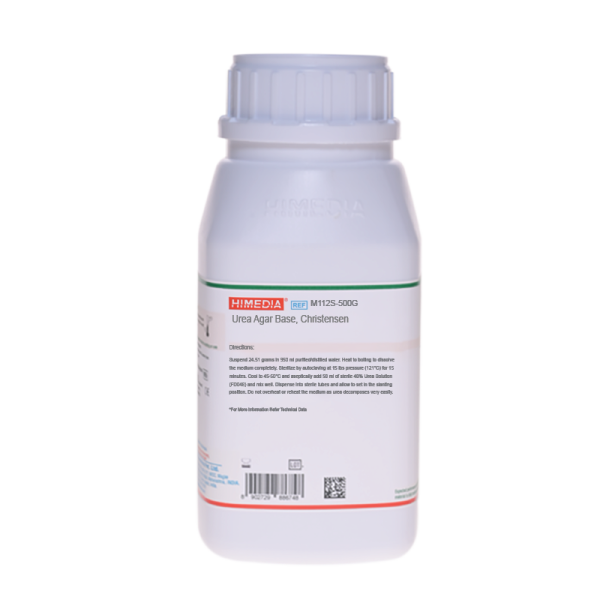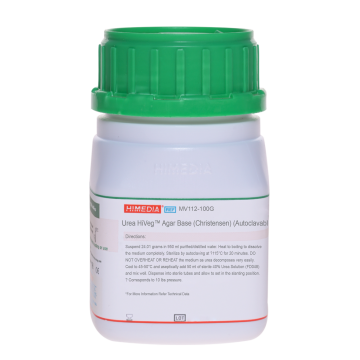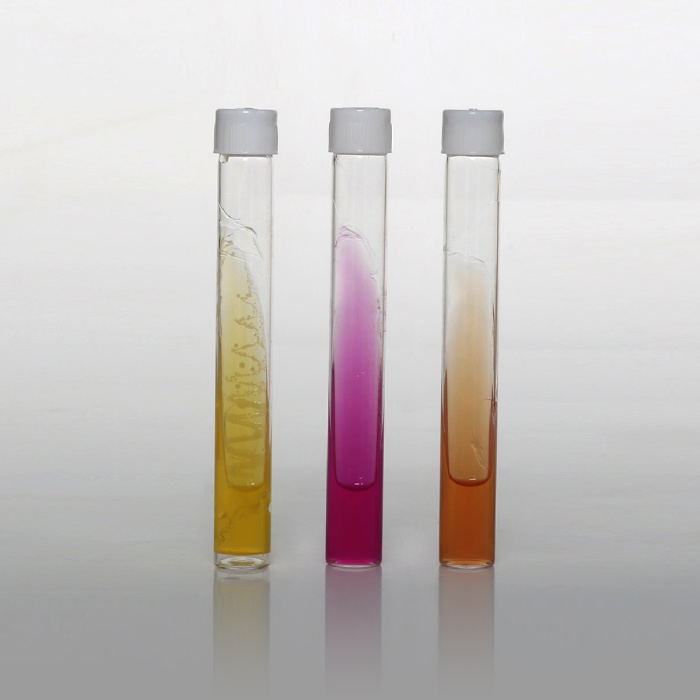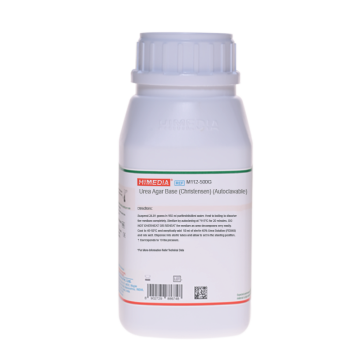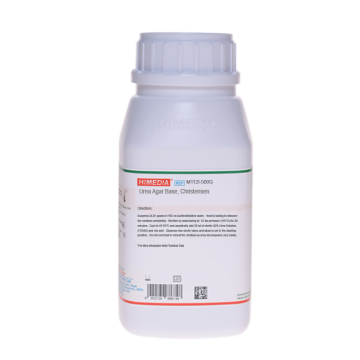 Your enquiry has been submitted
Your enquiry has been submitted
Urea Agar Base (Christensen)
Urea Agar Base is recommended for the detection of urease production, particularly by Proteus vulgaris, Micrococci and paracolon organisms.
Composition**
| Ingredients | Gms / Litre |
|---|---|
| Dextrose | 1.000 |
| Peptic digest of animal tissue | 1.500 |
| Sodium chloride | 5.000 |
| Monopotassium phosphate | 2.000 |
| Phenol red | 0.012 |
| Agar | 15.000 |
Final pH (at 25°C): 6.8±0.2
**Formula adjusted, standardized to suit performance parameters
Directions
Suspend 24.51 grams in 950 ml distilled water. Heat to boiling to dissolve the medium completely. Sterilize by autoclaving at 15 lbs pressure (121°C) for 15 minutes. Cool to 50°C and aseptically add 50 ml of sterile 40% Urea Solution (FD048) and mix well. Dispense into sterile tubes and allow to set in the slanting position. Do not overheat or reheat the medium as urea decomposes very easily.
Principle And Interpretation
Urea Agar Base Media is a slight modification of Christensen formulation (1, 2) and is recommended by BIS (3, 4) for identification of urease activity. Rustigian and Stuart (5) had originally formulated a medium to detect urease activity. These media differentiate between rapid urease positive Proteus species and other urease positive organisms like Citrobacter, Enterobacter and Klebsiella and the bacteria other than Enterobacteriaceae. Christensen observed that addition of peptic digest of animal tissue, dextrose and reduced content of buffer helps to support an early luxuriant growth.
Heavy inoculum of growth is inoculated on the surface of the slants. When urea is utilized, ammonia is formed during incubation which makes the medium alkaline, showing a pink-red colour by the change in the phenol red indicator. Prolonged incubation may cause alkaline reaction in the medium. Check using medium without urea as the negative control.
Quality Control
Appearance: Light pink coloured homogeneous free flowing powder
Gelling: Firm, comparable with 1.5% Agar gel
Colour and Clarity of prepared medium: Yellowish orange coloured clear gel forms in tubes as slants.
Reaction: Reaction of 2.45% w/v aqueous solution at 25°C. pH: 6.8±0.2
pH: 6.60-7.00
Cultural Response
Cultural characteristics observed after an incubation at 35-37°C for 18-24 hours.
| Organism | Inoculum (CFU) | Growth | Urease |
|---|---|---|---|
| Enterobacter aerogenes ATCC 13048 | 50-100 | luxuriant | Negative reaction, no change |
| Escherichia coli ATCC 25922 | 50-100 | luxuriant | Negative reaction, no change |
| Klebsiella pneumoniae ATCC 13883 | 50-100 | luxuriant | Positive reaction, cerise colour |
| Proteus mirabilis ATCC 12453 | 50-100 | luxuriant | Positive reaction, cerise colour |
| Proteus vulgaris ATCC 13315 | 50-100 | luxuriant | Positive reaction, cerise colour |
| Salmonella Typhimurium ATCC 14028 | 50-100 | luxuriant | Negative reaction, no change |
Storage and Shelf Life
Store below 30°C in tightly closed container and the prepared medium at 2 - 8°C. Use before expiry date on the label.
Reference
- Christensen, W.B., 1946, J. Bact., 52:461.
- MacFaddin J., 1980, Biochemical Tests for Identification of Medical Bacteria, 2nd ed., Williams and Wilkins, Baltimore.
- Bureau of Indian Standards, IS: 5887 (Part I) - 1976, reaffirmed 1986.
- Bureau of Indian Standards, IS: 5887 (Part III) - 1999.
- Rustigian and Stuart, 1941, Proc. Soc. Exp. Biol. Med., 47:108.
| Product Name | Urea Agar Base (Christensen) |
|---|---|
| SKU | M112S |
| Product Type | Regular |
| Physical Form | Powder |
| Origin | Animal |
| Packaging type | HDPE |
| References | 1. Christensen, W.B., 1946, J. Bact., 52:461. 2.MacFaddin J., 1980, Biochemical Tests for Identification of Medical Bacteria, 2nd ed., Williams and Wilkins, Baltimore. 3.Bureau of Indian Standards, IS : 5887 (Part I) - 1976, reaffirmed 1986. 4.Bureau of Indian Standards, IS : 5887 (Part III) - 1999. 5.Rustigian and Stuart, 1941, Proc. Soc. Exp. Biol. Med., 47:108. |
| Customized Product Available | No |



